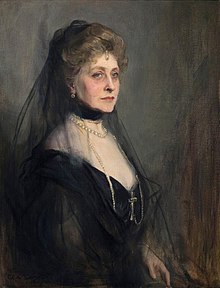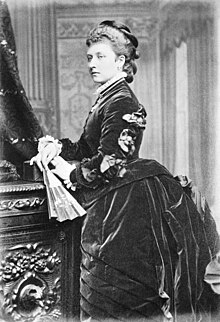Louise, Duchess of Argyll
Princess Louise Caroline Alberta of Great Britain and Ireland, Duchess of Argyll VA (born March 18, 1848 in Buckingham Palace , London , † December 3, 1939 in Kensington Palace , London) was a member of the British royal family . She was the sixth child of Queen Victoria and Prince Albert of Saxe-Coburg and Gotha .
Early years
Louise was named in honor of her paternal grandmother Louise von Sachsen-Gotha-Altenburg . In her youth, Louise was subjected to the strict upbringing regulations that her father had drawn up for his children. She was considered an intelligent and especially artistically gifted child. After the early death of her father, she resisted the years of mourning that Queen Victoria kept. From 1866 she took over the duties of her mother's unofficial private secretary, which she did well, contrary to her expectations.
Louise supported liberal ideas and was close to the women's movement . She was considered the prettiest daughter of the Queen, so that the press said she had romantic affairs. Therefore, the queen endeavored to find a husband for her daughter who would suit both her and Louise.
After various foreign princes were not considered due to foreign policy considerations, the princess decided to marry John Douglas Sutherland Campbell, Marquess of Lorne . The marriage, which took place at St George's Chapel in Windsor Castle in 1871 , was controversial because it was the first marriage between a daughter of a British monarch and a British citizen, i.e. not a foreign prince from a ruling or mediatized house, since 1515. The marriage remained childless.
Canada
In 1878 Louise's husband, who had previously been a member of the House of Commons , was appointed Governor General of Canada by the Queen on a proposal from the government . Both lived at Rideau Hall in Ottawa until the end of their tenure in 1883 .
Both promoted art in particular. This suited Louise's abilities and interests. On the other hand, there were always conflicts with the press, but also with the population, who had difficulties with the noble status of the couple.
Later years
Upon returning to the UK, the couple moved to Kensington Palace , where Louise stayed for the rest of her life. The couple grew apart and often went their own way. The reason for this was, among other things, her husband's political career, which stood in contrast to the neutrality of the royal family.
There were also rumors of the Marquess' homosexuality . Louise herself had various romantic relationships during these years, including Arthur Bigge , the royal private secretary, and Sir Edwin Lutyens ; that these were also sexual in nature has not been proven. Allegedly, Louise also had an affair with Prince Heinrich von Battenberg , her sister Beatrice's husband.
Louise took on duties in the royal family and represented the queen on a variety of occasions. She was considered an open-minded and unconventional member of the royal family. So she was treated by Elizabeth Garrett Anderson , the first woman doctor in the UK. She also had a keen interest in physical exercise. Furthermore, she continued to pursue her artistic hobbies; she was particularly fond of sculpture . She was a student of the sculptor Sir Joseph Boehm , statues made by her still stand on the Isle of Wight and in Montreal .
After the death of her father-in-law in 1900, her husband inherited his title, so that Louise became Duchess of Argyll. Her mother, Queen Victoria, died a year later. She inherited from her a property on the grounds of Osborne House . However, the family continued to live beyond their means, which resulted in considerable economic difficulties.
In the following years the Duke's health deteriorated noticeably, he became senile . Louise took care of him so that the couple grew closer again. The duke died in May 1914.
In the last few decades of her life, Louise rarely appeared in public. Rather, she lived secluded in her premises in Kensington Palace in the immediate vicinity of her sister Beatrice . She died in December 1939 and was buried after her cremation in Golders Green Crematorium on the Royal Burial Ground Frogmore .
Title, medal and coat of arms

Title and salutation
- 1848–1871: Her Royal Highness The Princess Louise
- 1871-1900: Her Royal Highness The Princess Louise, Marchioness of Lorne
- 1900–1939: Her Royal Highness The Princess Louise, Duchess of Argyll
medal
- January 21, 1865: Lady of the Royal Order of Victoria and Albert
- January 1, 1878: Companion of the Order of the Crown of India
- February 10, 1904: Royal Family Order of King Edward VII.
- June 3, 1911: Royal Family Order of King George V.
- June 3, 1918: Dame Grand Cross of the Order of the British Empire
- June 12, 1927: Dame Grand Cross of the Venerable Order of St. John
- May 11, 1937: Dame Grand Cross of the Royal Victorian Order
Military honor ranks
-
 July 3, 1911: Colonel of Honor of the 4th Princess Louise Dragoon Guards
July 3, 1911: Colonel of Honor of the 4th Princess Louise Dragoon Guards
-
 June 22, 1914: Colonel of Honor of The Argyll and Sutherland Highlanders (Princess Louise's)
June 22, 1914: Colonel of Honor of The Argyll and Sutherland Highlanders (Princess Louise's)
-
 April 15, 1930: Colonel of Honor of The Argyll and Sutherland Highlanders of Canada (Princess Louise's)
April 15, 1930: Colonel of Honor of The Argyll and Sutherland Highlanders of Canada (Princess Louise's)
coat of arms
In 1858 Louise and her three younger sisters were allowed to bear the coat of arms of the United Kingdom . As is usual with women, it was not designed as a shield, but as a diamond ("lady's shield"). Until 1917 it carried the coat of arms of Saxony as a central shield .
Worth mentioning
The Canadian province of Alberta and Mount Alberta as well as the city of Louiseville and Lake Louise , both also in Canada, are named after her.
literature
- Daphne Bennett: Queen Victoria's Children , Victor Gollanz Ltd., London 1980
- EF Benson: Queen Victoria's Daughters , Appleton & Company, 1938
- JE Collins: Canada Under the Administration of Lord Lorne , Rose Publishing Company, Toronto 1884
- David Duff: The Life Story of HRH Princess Louise Caroline Alberta, Duchess of Argyll , Cedric Chevers Ltd., Bath 1971
- D. Blake McDougall Edmonton: Princess Louise Caroline Alberta , detailed biography on the website of the Legislative Assembly of Alberta , 1988 (English)
- Henry James Morgan: Types of Canadian women and of women who are or have been connected with Canada , Toronto 1903, online in the Internet Archive at archive.org (English)
- Mark Stocker: Louise, Princess, duchess of Argyll (1848–1939). In: Henry Colin Gray Matthew, Brian Harrison (Eds.): Oxford Dictionary of National Biography , from the earliest times to the year 2000 (ODNB). Oxford University Press, Oxford 2004, ISBN 0-19-861411-X , ( oxforddnb.com license required ), as of January 2008
- Jehanne Wake: Princess Louise: Queen Victoria's unconventional daughter , Collins, London 1988, ISBN 0-00-217076-0
Web links
- Louise Caroline Alberta Saxe-Coburg and Gotha, Princess of the United Kingdom on thepeerage.com
- Entry at getty.edu (English)
Individual evidence
- ↑ Wake, p. 68
- ↑ Heraldica - British Royalty cadency
| personal data | |
|---|---|
| SURNAME | Louise, Duchess of Argyll |
| ALTERNATIVE NAMES | Duchess of Argyll; Princess Louise Caroline Alberta of Saxe-Coburg and Gotha |
| BRIEF DESCRIPTION | Daughter of Queen Victoria |
| DATE OF BIRTH | March 18, 1848 |
| PLACE OF BIRTH | London |
| DATE OF DEATH | December 3, 1939 |
| Place of death | London |



